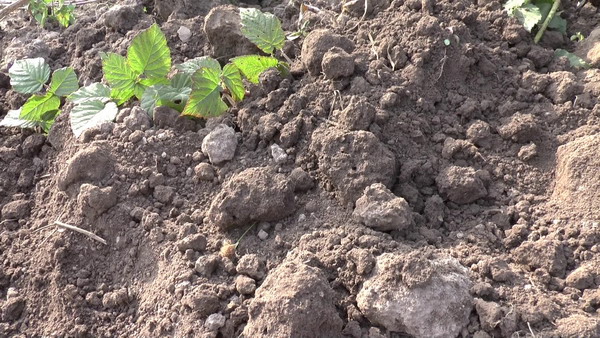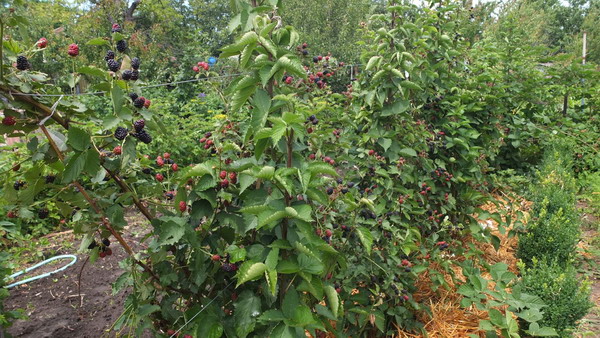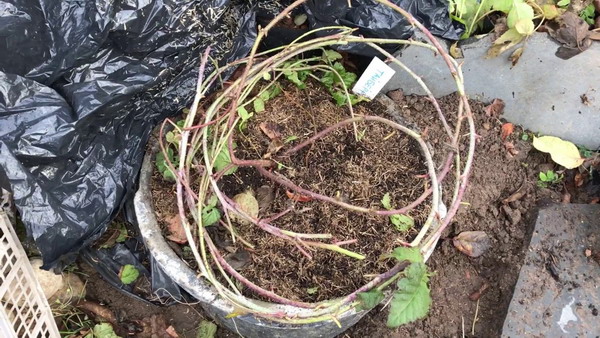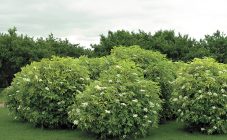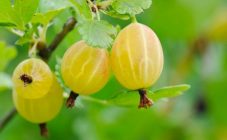Content:
Breeders justify the desire of gardeners to grow the best fruits and vegetables on their personal plot, developing new varieties of crops that require less care, but give a good harvest. A hybrid of raspberries and blackberries, which received the symbolic name of ezhemalina, is no exception. These berries have a raspberry-blackberry sweet and sour taste.
What is ezhemalina, breeding history
Ezhemalina was bred by accident by Californian breeder James Harvey Logan in the early 80s of the 18th century. He tried to cross different varieties of blackberries to obtain large and beautiful berries for commercial purposes. But blackberries and raspberries by chance grew close to each other at his house, as a result, pollination occurred, and a completely new species, previously unknown to breeders, appeared - a hybrid ezhemalina, called Loganbury.
To date, a large number of ezemalina species have been bred, the most popular are the ezemalina varieties by Merry Berry, Thornfrey, Tabury, Darrow, Rubus Hybrid, Medana, etc.
The raspberry-blackberry hybrid Tayberry deservedly received the greatest love and respect. It was bred at a research institute in 1979 in Scotland by crossing Jewel raspberries and Aurora blackberries. The name was given in honor of the Tay River, on the banks of which the institute is located. This variety is widely used to this day in America, in a number of European countries, the CIS countries. It is also grown in Moscow and the Moscow region, Voronezh, Rostov, Siberia and other, more southern regions.
The raspberry of the Taibury variety received universal love due to its high yield, unpretentious care, excellent taste. That is why in our region it is most often grown commercially, but amateur gardeners do not neglect this variety on their plots.
A distinctive feature of the Tayberry variety is its high yield. During the season, from one bush, you can collect an average of 4 to 6 kg of fruit. An adult shrub is capable of yielding up to 10 kg, taking into account the correct wintering. The plant bears fruit only 3 years after planting.
Tiberi blooms from mid-May. Flowering lasts for 1-1.5 weeks, and the first fruits ripen by mid-June and first half of July. The flowering bush is stunningly beautiful, able to decorate any personal plot.
The berries ripen within a few days. During this time, the color of the fruit changes from light to bright cherry hue. Fruiting lasts about a month. The berries are of a triangular elongated shape, of a bright red hue, about 5 cm in length and weighing up to 15 grams. The taste is raspberry and blackberry at the same time, moderately tart and sweet. The consistency of the berries is dense, after picking they are perfectly stored and transported. But after overripe, the berries become soft and quickly lose their original shape. Suitable for fresh consumption, as well as for rolling and baking, rich in vitamins.
The disadvantages of a Tayberry hybrid between raspberries and blackberries include medium resistance to frost. That is why preparation of the variety for wintering is required.In addition, a characteristic feature of the tiberi is the presence of sharp thorns, which significantly complicates care and harvesting.
In 1996, the Buckingham Tayberry variety was bred, a distinctive feature of which is the absence of sharp thorns. But the size of the berries in the species is smaller, and they taste much sour.
Blackberry Tayberry belongs to the climbing species, the length of the stems reaches 4 meters. The stems are distinguished by good elasticity, bend well. The color of the stems is directly related to the age of the plant: annuals have a lighter shade of green, after several years the color changes, acquiring darker burgundy notes. The shade of the foliage is always bright green.
How to choose healthy seedlings when buying
A large role in the cultivation of the raspberry-blackberry hybrid Tiberi has a choice of seedlings. When buying, you should pay attention to a number of features:
- the seedling must have a sufficiently developed root system, there must be no signs of decay and parasite infestation;
- the seedling must have at least 3 buds, which guarantee quick survival when planting;
- the presence of stems is required;
- you should not give preference to large seedlings - they take root much worse.
Important! After the purchase, you need to wrap the root system with a damp cloth and plant it in the ground as soon as possible, in order to avoid root rot.
Rules for planting seedlings ezhemalina
Ezhemalina Taibury planting and care includes the right spot, mulching, watering, pest control, garter.
Selecting and preparing a site on the site
A plot for Tayberry raspberries is chosen taking into account good sunlight and a minimum amount of shade. The presence of a shelter in the form of a wall from the winds is encouraged.
The soil is pre-fertilized. Since autumn, humus, bird manure, ash can be scattered on the surface of the earth, and everything can be carefully dug up. In this case, planting is possible only in spring.
Another option for fertilizing the soil is the use of superphosphates (about 100 g) in combination with potassium sulfate (about 50 g) per planting bush. Fertilizers are scattered over the surface with an even layer, everything is carefully dug up.
Attention! Planting is possible after a couple of weeks, not earlier.
The process and scheme of planting seedlings
If the soil is prepared on time, it can be planted in autumn, spring and even summer, choosing the evening time for planting. The distance between the bushes should be at least 1.5-2 meters, and between the rows - from 2.5 meters or more. Planting can be carried out according to 2 schemes with separate bushes (bush method) or in the form of a tape (tape method). With the bush method, individual pits are dug with a depth and diameter of about 50-60 cm.In the case of belt planting, a trench is dug about 40 cm wide and 50-60 cm deep.
Humus (1 kg), wood ash (500 g) or mineral fertilizers in the form of potassium sulfate (40 g), etc. are placed on the bottom of the pit. Top fertilizers are sprinkled with earth about 10-15 cm.
The root system of the seedling is straightened and evenly distributed over the diameter of the hole, while the root collar is sunk into the ground literally a couple of centimeters. At the final stage, at least 4-5 liters of water are poured under each bush. If planting occurs in the autumn, the stem is cut to a height of 30 cm and covered with a plastic bottle. This will help the seedling survive the winter.
Seasonal care rules
Ezhemalina, like any other crop, requires a certain seasonal care, which includes: protection from pests, timely watering and mulching, soil fertilization, weed removal, and a trellis tie.
Protection from pests and diseases
Ezhemalina Tayberry is quite resistant to pests, but aphids and gall midges often affect it.
The stem gall midge resembles a mosquito; it affects the plant during the flowering period, laying its larvae on the buds, while feeding on young shoots.The site of the stem lesion "swells", the bark bursts. Ezhemalina stops growing. That is why it is very important in late autumn and early spring to cut off all diseased and dry branches, which are subsequently burned.
Raspberry aphids literally "suck" the weight of the juice from the leaves of the plant. At the same time, they curl and dry out. To combat aphids, chemical components are used, for example, nitrafen (diluted at the rate of 40 grams per 10 liters of water), karbofos (40 grams per 5 liters of water). Until the buds appear, the plant is abundantly sprayed with the resulting solution using a syringe.
Watering and mulching the soil
Tayberry does not tolerate drought well, and therefore requires weekly watering. In cool weather, 5 liters of water for each bush will be enough. In the summer, it is recommended to irrigate only in the evening with at least 10 liters of water.
Mulching the soil also has a beneficial effect on the plant. Wood chips, dry foliage or grass can be used as mulch. The procedure should be carried out at the end of autumn, scattering mulch about a meter in diameter around the bush with a thickness of at least 7 cm. This will protect the root system from low temperatures. In early spring, all the soil is carefully dug up so as not to damage the roots, thereby saturating the earth with oxygen and nutrients.
Weed control
In this case, do not forget to remove weeds as necessary. It is better to do this manually, without using chemicals that can damage the shrub. Or, at the beginning of spring, cover the soil around the bush with a black covering material, for example, agrofibre, with a density of 60 grams. for 1 sq.m. The black color of agrofibre prevents the growth of weeds, while allowing moisture to pass through without harming the plant.
Fertilization
Fertilizing the soil is best done in autumn or early spring. You can feed it with mineral fertilizers of factory production, for example, the Polish manufacturer Ogrod 2001 (about 500 rubles of the Russian Federation for 2 kg). Fertilizer is evenly spread over the soil surface about 30-40 grams. per sq. meter, then everything is carefully dug up and watered abundantly with water. The procedure can be repeated up to 3 times a year. Or you can use rotted manure at the rate of half a bucket per square meter. In this case, the procedure can be repeated no more than 2 times a year.
Trellis garter
It is worth not forgetting about tying up the yogurt. It is recommended to place it on trellis about 2 meters high, factory-made, or prepare it yourself, using pipes, fittings, stakes and wire, creating a kind of 3-tiered arch.
The garter is carried out in the spring, after all the dried and pest-affected branches have been removed. It is recommended to place fruiting branches in the upper tier of the trellis, and new shoots in the lower part.
Pruning and shaping the bush
Shrub pruning is carried out in late autumn or early spring, the opinions of summer residents differ on this issue. If pruning is scheduled for spring, this should be done as soon as the frost has passed and the buds have not yet blossomed. All diseased and damaged branches are cut, while only young shoots remain. A couple of weeks after pruning, all branches are tied to a trellis. Young shoots can be launched on the ground, tying them together, thereby forming a bush growing in the desired direction.
Preparing for winter
Preparation for winter includes pruning fruiting stems, the remaining stems bend to the ground and covered with a protective covering cloth of the appropriate density of white. The density must be at least 60 grams. per sq. meter.
Important! You can lay the shoots on a sheet of plywood, sprinkling them with earth. Do not overdo it and sprinkle too abundantly, so as not to damage the branches from the severity.
Reproduction of Taybury's nezemalina occurs with the help of cuttings. For this, the tops of young shoots are bent to the ground and sprinkled on it. By the fall, the stalk takes root.And after a year it can be separated from the main shrub and planted using the standard method.
As you can see, the description and characteristics of the variety allows you to grow it in almost any region of the country. But the Taybury Yezemalina requires care, then the cultivation of agriculture will bear fruit in the form of juicy and very useful berries that children like so much.


